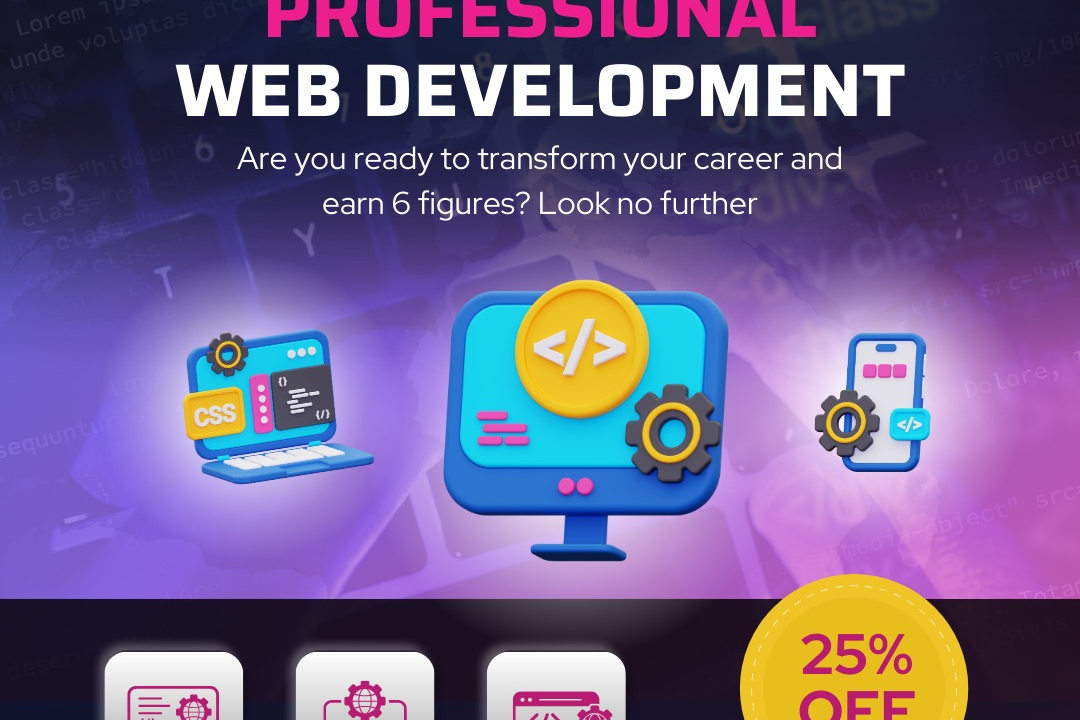Get PHP Programs Online
Get PHP programs online are interactive scripts that demonstrate how to use the GET method in PHP to
Get PHP Programs Online
PHP programs that utilize the GET method available online are valuable tools for learning and testing how data can be sent and retrieved through URL parameters. They enable users and developers to see real-time results of data transmission, making it easier to understand how server-side scripts interact with user input. These programs facilitate quick experimentation, troubleshooting, and development of dynamic web applications, ultimately helping users to grasp essential concepts of data handling, improving their coding skills and aiding in efficient web development.
To Download Our Brochure: https://www.justacademy.co/download-brochure-for-free
Message us for more information: +91 9987184296
PHP programs that utilize the GET method available online are valuable tools for learning and testing how data can be sent and retrieved through URL parameters. They enable users and developers to see real time results of data transmission, making it easier to understand how server side scripts interact with user input. These programs facilitate quick experimentation, troubleshooting, and development of dynamic web applications, ultimately helping users to grasp essential concepts of data handling, improving their coding skills and aiding in efficient web development.
Course Overview
The ‘Get PHP Programs Online’ course offers a comprehensive introduction to using PHP with the GET method, enabling learners to build dynamic web applications by sending and retrieving data via URL parameters. It covers core concepts, hands-on coding, and real-time project execution, equipping students with practical skills to develop and test PHP programs efficiently in an online environment.
Course Description
The ‘Get PHP Programs Online’ course provides a hands-on introduction to PHP's GET method, teaching students how to create dynamic web applications by sending and retrieving data via URL parameters, with practical exercises and real-time project experience.
Key Features
1 - Comprehensive Tool Coverage: Provides hands-on training with a range of industry-standard testing tools, including Selenium, JIRA, LoadRunner, and TestRail.
2) Practical Exercises: Features real-world exercises and case studies to apply tools in various testing scenarios.
3) Interactive Learning: Includes interactive sessions with industry experts for personalized feedback and guidance.
4) Detailed Tutorials: Offers extensive tutorials and documentation on tool functionalities and best practices.
5) Advanced Techniques: Covers both fundamental and advanced techniques for using testing tools effectively.
6) Data Visualization: Integrates tools for visualizing test metrics and results, enhancing data interpretation and decision-making.
7) Tool Integration: Teaches how to integrate testing tools into the software development lifecycle for streamlined workflows.
8) Project-Based Learning: Focuses on project-based learning to build practical skills and create a portfolio of completed tasks.
9) Career Support: Provides resources and support for applying learned skills to real-world job scenarios, including resume building and interview preparation.
10) Up-to-Date Content: Ensures that course materials reflect the latest industry standards and tool updates.
Benefits of taking our course
Functional Tools
1 - Online PHP Editors and IDEs: The course utilizes web based PHP editors such as PHP Fiddle, 3v4l, and PHP Fiddle, which allow students to write, run, and debug PHP scripts directly within their browsers without any local setup. These tools support real time code execution, syntax highlighting, and error detection, enabling learners to experiment freely and reinforce their understanding of GET request handling. They foster an interactive learning environment where students can instantly see the results of their code modifications, facilitating faster learning and troubleshooting. The convenience of accessible online tools allows students to practice from any device or location, making the learning process flexible and adaptable to individual schedules.
2) Web Browsers: Modern browsers like Chrome, Firefox, Edge, and Safari are integral to testing PHP programs that handle GET requests. These browsers serve as the front end for making GET requests to PHP scripts hosted on local servers or online platforms. They help students observe how URL parameters are transmitted, how web pages respond, and how browser caching and history functionalities work with GET requests. Using different browsers ensures that students understand cross browser compatibility issues and learn to create robust, universally accessible web applications. Browsers also provide built in developer tools, such as network inspectors, which assist students in analyzing HTTP requests and responses for better debugging.
3) Local Server Environments: Tools such as XAMPP, WAMP, or MAMP are discussed in the course for setting up local testing environments. These platforms simulate a live server on the student’s machine, allowing PHP code to run just as it would on a web hosting server. They support Apache, PHP, and MySQL, making it easier to develop and test more complex projects involving database interactions along with GET requests. These environments help students understand the server side execution process, URL routing, and request response cycles—integral components of developing comprehensive web applications. The course emphasizes configuring and managing these tools to create a practical development setup.
4) Version Control Systems: Git and GitHub are introduced to demonstrate best practices in collaborative development and code management. Students learn to track changes, create branches, and manage repositories for their PHP projects. This facilitates organized coding, allows easy rollback of buggy code, and promotes teamwork during project development. Learning version control prepares students for real world development environments, ensures code safety, and simplifies sharing and deployment processes. The tools also provide a platform for peer review and feedback, enhancing the overall quality of the projects delivered.
5) Online Learning Platforms and Resources: The course incorporates platforms like Udemy, Coursera, and YouTube tutorials for supplementary learning. These resources provide additional explanations, coding demonstrations, and problem solving techniques related to PHP GET requests. They serve as valuable references for self paced learning, enabling students to explore more advanced topics, industry best practices, and recent updates in PHP technology. Access to a wealth of online tutorials and forums helps reinforce classroom learning, resolve doubts quickly, and stay updated with new trends in web development.
6) Debugging and Testing Tools: Integrated development tools such as Chrome DevTools, Postman, and WebPageTest are employed to analyze HTTP traffic and test GET request responses. Chrome DevTools helps students inspect URL parameters, monitor network activity, and identify client side issues, while Postman allows testing API endpoints handling GET requests independently of the frontend. These tools enhance troubleshooting skills, help verify server responses, and optimize performance, ensuring students can develop secure, efficient, and bug free PHP applications. They also provide insights into how GET data is transmitted and processed, deepening the learner’s practical knowledge.
7) Database Management Tools: Software like phpMyAdmin, MySQL Workbench, or Adminer is used to facilitate database interactions within the course. Students learn to connect their PHP scripts with databases to store, retrieve, and manipulate data based on GET request parameters. These tools support visual database design, query execution, and data management, giving learners a comprehensive understanding of backend processes. Integrating databases with PHP programs demonstrates real world use cases, such as filtering products or user data, and enhances the application’s functionality and robustness. Proper database handling is emphasized to ensure data security and integrity.
8) Cloud Hosting Platforms: The course also explores cloud services like Heroku, AWS, and DigitalOcean to host PHP applications online. These platforms enable students to deploy their code, simulate live environments, and test GET request handling at scale. Learning to deploy on cloud services prepares students for real world situations where web applications need to be accessible to users globally. The tools offer scalability, security, and performance monitoring features, which are crucial for professional web development. Students gain insight into deployment workflows, server configurations, and managing uptime, which are essential skills for a software development career.
9) Content Management Systems (CMS): Though primarily used as a framework, CMS like WordPress and Joomla can be integrated with custom PHP scripts to handle GET requests. The course discusses how these platforms process URL parameters for dynamic content rendering, user authentication, and content filtering. Understanding GET request handling within CMS environments allows students to build custom plugins, widgets, or modules that extend the core functionalities. It also introduces concepts of secure parameter handling and best practices to prevent common vulnerabilities like URL injection or parameter tampering.
10) Responsive Design Tools: Frameworks such as Bootstrap and Materialize are shown to ensure that web pages utilizing GET requests are mobile friendly and responsive. While these tools primarily deal with front end design, the course emphasizes the importance of responsive layouts in enhancing user experience when interacting with GET based web pages. Integrating responsive design ensures that users across various devices can efficiently send GET requests and view responses, highlighting the importance of UI/UX in web development.
11 - Learning Management System (LMS) Platforms: Platforms like Moodle and Canvas are used to deliver course content, quizzes, and assignments related to PHP GET requests. These systems facilitate structured learning, track student progress, and provide instant feedback. They serve as a controlled environment for assessments and reinforce theoretical concepts with practical exercises, ensuring comprehensive understanding of request handling, URL parameters, and data security.
12) Security and Encryption Tools: The course includes sessions on using SSL/TLS certificates and security plugins to protect data transmitted via GET requests. Students learn how to secure URL parameters against interception or tampering, ensuring confidentiality and integrity of sensitive information. Knowledge of security tools like CAPTCHA, input validation, and sanitization techniques help prevent common web vulnerabilities, promoting best practices for secure web applications.
13) Testing and Continuous Integration (CI) Tools: Platforms like Jenkins or Travis CI are introduced to automate testing of PHP scripts involving GET requests. These tools help in setting up automated test suites, code quality checks, and deployment pipelines, ensuring that applications work reliably across updates. Incorporating CI fosters disciplined development habits and ensures robustness in handling various request scenarios.
14) Containerization Tools: Docker is discussed for creating isolated environments for PHP development and testing. Containers replicate real world server configurations, allowing students to test GET request functionalities consistently across different systems. Learning containerization helps in maintaining development environments, simplifies deployment, and ensures that projects are portable and scalable.
15) Performance Optimization Tools: Tools like Google Lighthouse and WebPagetest are used to analyze and optimize the performance of PHP driven websites that utilize GET requests. They help identify bottlenecks, optimize load times, and improve overall user experience. This emphasizes the importance of performance tuning in web applications, ensuring swift and efficient data handling.
16) API Development and Documentation Tools: Postman and Swagger are introduced to help students develop, test, and document RESTful APIs that leverage GET requests. Proper API documentation and testing streamline the integration process for future projects or team collaborations. These tools foster industry standard practices, making students proficient in designing APIs that are secure, efficient, and developer friendly.
17) Educational Coding Platforms: Interactive coding platforms like CodePen, JSFiddle, or Replit offer sandbox environments where students can experiment with PHP GET request scripts in real time. These platforms encourage exploratory learning and fast prototyping, making it easier for learners to grasp how URL parameters influence dynamic content generation and data retrieval.
18) Collaboration and Communication Tools: Slack, Microsoft Teams, and project management tools like Jira or Trello are discussed for team coordination during project development involving PHP GET requests. Effective communication and collaboration enable developers to share insights, review code, and troubleshoot issues efficiently, reflecting real world software development workflows.
19) Analytics and Monitoring Tools: Google Analytics and server side logs are used to track user interactions with pages that rely on GET requests. These insights help in understanding user behavior, optimizing URL structures, and enhancing site performance and security. Monitoring tools also assist in diagnosing issues related to URL parameter handling and potential attack vectors.
20) Education and Certification Platforms: Throughout the course, platforms like JustAcademy are used to deliver structured learning paths, assessments, and certification upon successful completion. These platforms ensure quality education, provide recognition for skills acquired, and serve as a portfolio piece for learners seeking employment in web development.
Browse our course links : https://www.justacademy.co/all-courses
To Join our FREE DEMO Session:
This information is sourced from JustAcademy
Contact Info:
Roshan Chaturvedi
Message us on Whatsapp: +91 9987184296
Email id: info@justacademy.co












